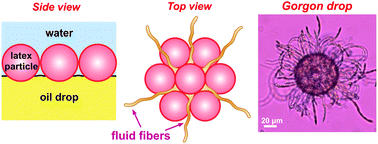Spontaneous particle desorption and “Gorgon” drop formation from particle-armored oil drops upon cooling

We study how the phenomenon of drop “self-shaping” (Denkov et al., Nature, 528, 2015, 392), in which oily emulsion drops undergo a spontaneous series of shape transformations upon emulsion cooling, is affected by the presence of adsorbed solid particles, like those used in Pickering emulsion stabilization. Experiments with several types of latex particles, and with added surfactant of low concentration to enable drop self-shaping, revealed several new unexpected phenomena: (1) adsorbed latex particles rearranged into regular hexagonal lattices upon freezing of the surfactant adsorption layer. (2) Spontaneous particle desorption from the drop surface was observed at a certain temperature-a remarkable phenomenon, as the solid particles are known to irreversibly adsorb on fluid interfaces. (3) Very strongly adhered particles to drop surfaces acted as a template to enable the formation of tens to hundreds of semi-liquid fibres, growing outwards from the drop surface, thus creating a shape resembling the Gorgon head from Greek mythology. Mechanistic explanations of all observed phenomena are provided using our understanding of the rotator phase formation on the surface of the cooled drops. The surface rotator phase creates positive line tension at the contact line formed between the particle surface and the fluid interface, which causes the particle ejection from the drop surface. This journal is

